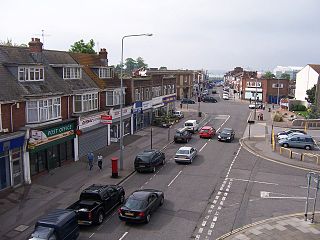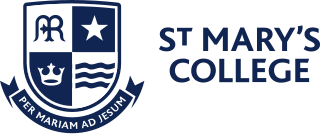
Bournemouth School is an 11–18 boys grammar school, with a co-educational sixth form, located in Charminster, Bournemouth, Dorset, England, for children aged 11 to 18. The school was founded by E. Fenwick and opened on 22 January 1901, admitting 54 boys.

St Anne's Catholic School is an 11-18 secondary school in Southampton, England, for girls. The school's sixth form is coeducational. The school is situated close to the city centre, and attracts pupils from all round the city and beyond. The school converted to academy status in August 2012. In January 2016, there were 1080 students enrolled, with 48 students at the end of Year 13.

Tadcaster Grammar School founded in 1557, is a coeducational secondary school and sixth form located near Tadcaster, North Yorkshire, England, educating children aged 11–18 years old, and has an on-site sixth form. The school is located in the hamlet of Toulston just outside the brewery town of Tadcaster. The school's catchment includes Tadcaster and its surrounding villages, while traditionally taking pupils from the York area, including villages such as Appleton Roebuck, Copmanthorpe, Bishopthorpe and Bilbrough.

Sholing, previously Scholing, is a district on the eastern side of the city of Southampton in Southern England. It is located between the districts of Bitterne, Thornhill and Woolston.

Woolston is a suburb of Southampton, Hampshire, located on the eastern bank of the River Itchen. It is bounded by the River Itchen, Sholing, Peartree Green, Itchen and Weston.
Firth Park Academy is a coeducational secondary school with academy status, located in the Shiregreen area of Sheffield, England.

Carre's Grammar School is a selective secondary school for boys in Sleaford, a market town in Lincolnshire, England.

Kesteven and Sleaford High School (KSHS), is a selective school with academy status for girls aged between eleven and sixteen and girls and boys between sixteen and eighteen, located on Jermyn Street in the small market town of Sleaford, Lincolnshire, England, close to Sleaford railway station.
Oxted School is a coeducational secondary school and sixth form located in the English town of Oxted, Surrey. It was opened in 1929 as the first mixed grammar school in Surrey and now has over 1,900 pupils aged 11–18.

St Mary's College is a coeducational Roman Catholic secondary school and sixth form located in Cranbrook Avenue, Kingston upon Hull, England. It was formed following an amalgamation between the former St Mary's Convent High School for Girls and Marist College for boys. In 2002 'The Academy' was built, as a sports centre for members of the school, and members of the public to use outside of school hours.

Downham Market Academy is a coeducational secondary school and sixth form with academy status, situated in Downham Market, Norfolk, England. The academy was launched on 1 July 2013, sponsored by the CWA Academy Trust founded by the College of West Anglia.
Wombourne High School is a coeducational secondary school and sixth form located in Wombourne, Staffordshire, England. It is situated on Ounsdale Road in the west of the village, and stands on an adjacent site to the local leisure centre. It also has an Invictus sixth form base campus on site for 16- to 19-year-olds, which has a built 6th form centre detachment which was opened by the pop star Beverley Knight. The schools is currently undergoing building, this includes; New window fixtures, A secondary entrance to the reception area with a disabled ramp and stairs.

The Grangefield Academy is a secondary school with academy status in the borough of Stockton on Tees, on Oxbridge Avenue, Grangefield, Stockton-on-Tees, a market town in the ceremonial county of County Durham, North East England.

Newquay Tretherras School is a secondary school with academy status in Newquay, Cornwall, England. The current headteacher is Samantha Fairbairn. The school first opened on 7 January 1954 and first secondary modern school to be built in Newquay.

New Mills School & Sixth Form is a comprehensive school, situated in the town of New Mills, in the north west of Derbyshire.

Totton College is a further education college located in Totton, Hampshire, providing courses for mainly 16- to 19-year-olds as well as adult education courses. These include BTECs, NVQs, GCSEs and Access courses. Courses are also available to students aged 14 and above who would benefit from additional hands-on experience and training in addition to their mainstream learning. A range of accredited professional and leisure courses are available to adults both in the daytime and evening.

Liskeard School and Community College is a coeducational secondary school and sixth form with former engineering specialist status, located in Liskeard, Cornwall, England.
The Broxbourne School is a coeducational secondary school and sixth form with academy status located in Broxbourne, Hertfordshire, England.
Callington Community College is a coeducational secondary school and sixth form with academy status, in Callington Cornwall.






















